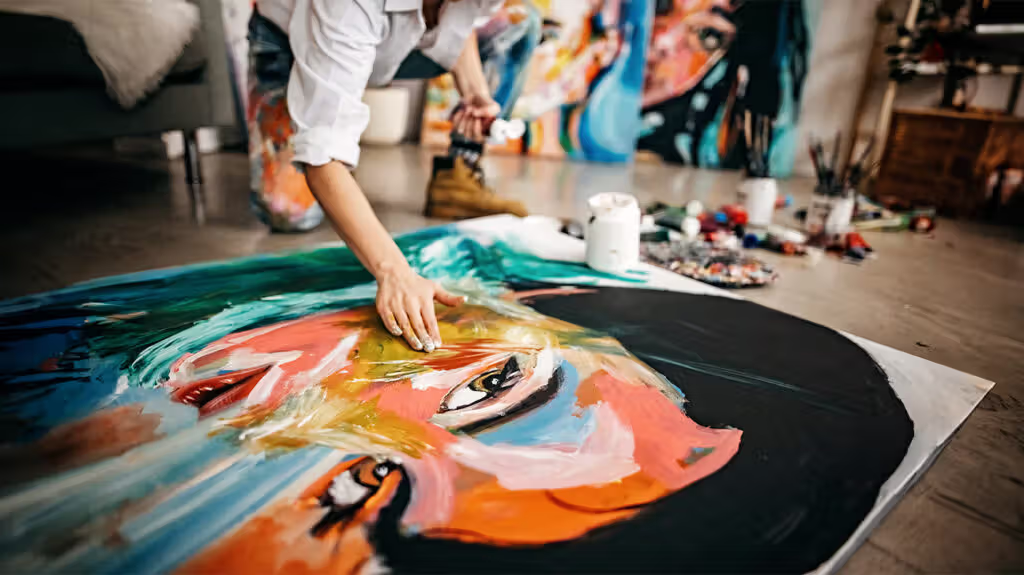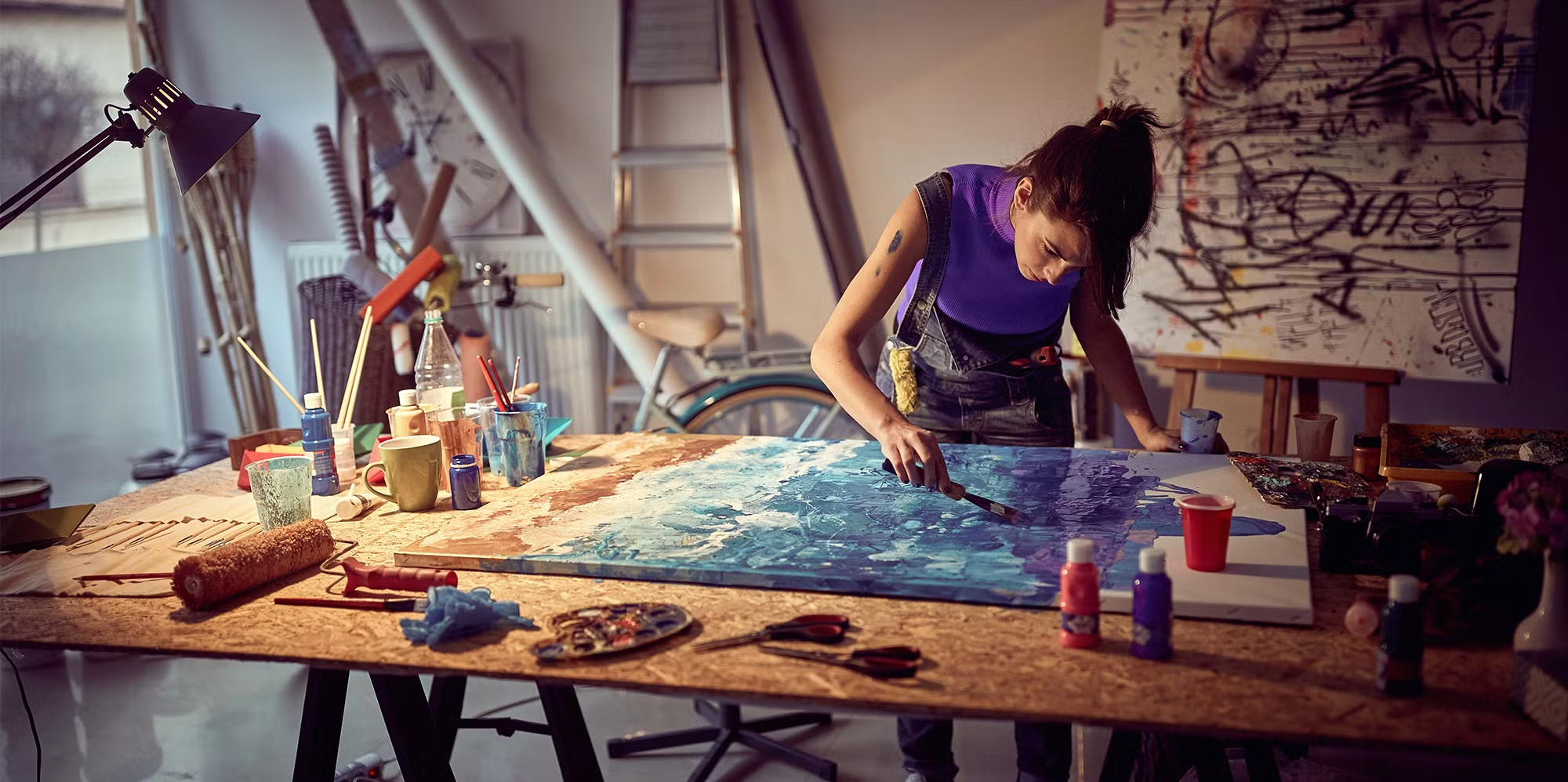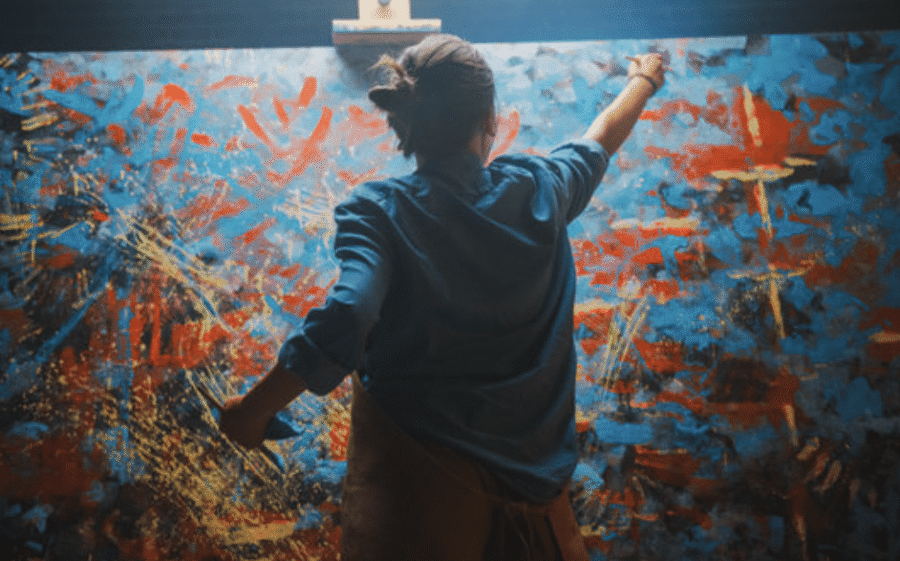The landscape of art funding is diverse, encompassing traditional residency formats and innovative digital and hybrid models.
Classical Residencies: Definition, Benefits, and Typical Offerings
Classical residencies involve a physical stay in a specific location, providing artists with a concentrated environment away from their usual routines. These locations can range from urban centers to tranquil landscapes.
The benefits of such programs are manifold:
- Physical Space and Undisturbed Time: Artists gain access to dedicated studios and living spaces conducive to intensive work and creative exploration. Examples include the Cité Internationale des Arts (35-60 m² live-in studios), Nordic Artists’ Centre Dale (private residency houses and 50 m² studios), and I-Park (private bedrooms and studios within a 450-acre nature preserve).
- Community and Networking: Opportunities arise for interaction with diverse international artists, fostering peer exchange, collaboration, and the building of a global network. The Cité Internationale des Arts alone hosts approximately 1,200 artists from about 100 countries annually.
- Access to Specific Resources: Specialized equipment, workshops (e.g., printmaking, ceramics, woodworking, dance studios), rehearsal spaces, and technical support are often included.
Typical offerings of classical residencies include:
- Accommodation: Provided in shared houses or private living spaces.
- Stipend: A monthly living stipend to cover daily expenses. For example, the Cité Internationale des Arts offers 1500 Euros gross per month, and the Nordic Artists’ Centre Dale provides 11,000 NOK monthly.
- Production Grants: Financial support for materials and project development. The Cité Internationale des Arts offers up to 5,000 Euros for visual arts.
- Mentoring and Professional Support: Guidance from established artists, curators, or institutional staff.
- International Visibility: Opportunities for exhibitions, performances, open studios, and networking events that increase global reach.

Digital & Hybrid Formats: Emergence and Opportunities
The emergence of digital and hybrid residency formats is a direct response to technological advancements and global challenges like travel restrictions. These models offer crucial alternatives for artistic engagement and creation.
The opportunities arising from these formats are considerable:
- Increased Accessibility: Geographical barriers are overcome, making residencies accessible worldwide, including to those with limited mobility or financial means for international travel. Res Artis and On the Move list online and virtual residency programs.
- Remote Collaboration: Projects between artists and technologists in different locations are facilitated using tools like Zoom, VR, and other remote collaboration platforms.
- VR/AR Experiments and New Media: Specific programs exist for artists working with immersive technologies, digital art, mixed realities, and computer-aided arts. Examples include the Onassis AiR/ONX Fellowships for immersive narratives with Mixed Realities and performative elements, the Hybrid Body Lab focusing on on-body design with miniaturized technology, and the CO-CREATE Residency of the IMC Lab for AR/VR/XR research and development.
- Online Labs and Workshops: Structured online learning environments, often combining online courses with intensive in-person phases, as seen in hybrid educational models.
The proliferation of digital and hybrid residency models signifies a fundamental shift towards utilizing new artistic media and collaborative paradigms. This indicates a growing demand for artists who can navigate and innovate in digital spaces, blurring the lines between physical and virtual creation. Artists should consider developing digital literacy, exploring mixed media, and seeking collaborations with technology experts. Funding institutions increasingly support these innovative approaches.
Supplementary Funding Programs
In addition to residencies, many institutions offer direct grants and support mechanisms:
- Grants: Direct financial contributions for living expenses or project development, often without a residency component.
- Production Grants: Financial support specifically for the creation or completion of artistic works.
- Mentoring Programs: Structured guidance from experienced professionals to help artists develop their practice and navigate their careers.
- International Visibility: Support for participation in international exhibitions, festivals, showcases, and networking events to increase global reach.

The Best Programs – Curated & Global
This section provides an overview of outstanding international and digital funding programs and residencies.
Goethe-Institut
The Goethe-Institut promotes culture and arts across disciplines, offering funding for artists for residencies and projects in Germany or abroad.
- Programs:
- DAAD Artists-in-Berlin Program: A respected artist-in-residence program for established artists in fine arts, film, literature, and music, awarding approximately 20 annual scholarships for a one-year stay in Berlin.
- Goethe Project Space (GPS) Grant Programme: Offers seed funding (up to R105,000, approx. US$5,900) for artistic initiatives in South Africa, Lesotho, and eSwatini.
- Transnational Cooperation Projects: Supports artistic and curatorial projects based on transnational, cooperative organizational structures, with a maximum funding of 25,000 Euros.
- Special Features: Strong focus on international collaboration and interdisciplinary formats.
Pro Helvetia
Pro Helvetia supports contemporary, professional Swiss art and cultural production to promote diversity and ensure national and international reach.
- Programs: Includes music, performing arts, visual arts, literature, design, and Art+. Offers creation and production grants, international tours, residencies, research trips, and programs for emerging artists.
- Art+: Specifically supports artistic collaborations between artists and experts from social and scientific sectors, focusing on transdisciplinary projects.
- Production Grants: For visual arts, applications are accepted annually from July 1 to September 1.
- Special Features: Generally supports artists established at a national level who have previously received Pro Helvetia funding. Film projects are not directly funded, but art projects using film/video as a medium are considered.
Onassis AiR (Athens, Greece)
Onassis AiR invites artists, curators, artisans, and other creative professionals from any medium or discipline worldwide.
- Programs for 2025/26 (33 grants):
- Extended Research Residencies: Three-month artistic residencies for developing or refining ongoing work.
- Dramaturgy Fellowships: Supports research and development of new performance-based work, primarily for practitioners from/based in Greece.
- Onassis AiR/ONX Fellowships: Focuses on proposals combining immersive narratives with Mixed Realities and performative elements.
- Technical Residencies: For art professionals in technical support to develop skills in expanded fields.
- Benefits: Artist’s fee, potential research/production budget, housing, travel to/from Athens, collective budget for group site-visits/research trips, networking, mentoring, and access to audiovisual equipment.
- Application: Deadline is March 7, 2025, for residencies between September 2025 and July 2026. Working language is English.

Cité Internationale des Arts (Paris, France)
The Cité Internationale des Arts hosts artists of all disciplines and nationalities in Paris, fostering creation and research within a vibrant artistic network.
- Programs (in partnership with Académie des beaux-arts):
- Visual Arts Program: 4 residencies of 10 months each (September 2025 – June 2026) for visual artists.
- Architecture & Landscape Program: 1 residency of 5 months for architects and landscape designers.
- Choreography Program: 1 residency of 5 months for choreographers.
- Benefits: Live-in studios (approx. 35-60 m²), monthly living stipend (1500 Euros gross), production grants (up to 5,000 Euros), artistic and professional support, and access to rehearsal studios (for choreography).
- Application: Applications by April 6, 2025. Duo/collective applications are accepted but share one studio/stipend.
Nordic Artists’ Centre Dale (NKD, Norway)
NKD is an independent foundation supporting emerging and established visual artists, architects, and designers.
- Benefits: Offers five private residency houses, five 50 m² studios, and a shared workshop/carpentry. Stipendiaries receive monthly stipends (11,000 NOK) and a travel grant (5,000 NOK).
- Special Features: Located in a rural setting in Norway, fostering research and development in a magnificent landscape. Open calls are announced annually in February.
I-Park Foundation (East Haddam, Connecticut, USA)
I-Park is an intimate, self-directed, multidisciplinary Artist-in-Residence program set within a 450-acre nature preserve. It supports music composition, creative writing, moving image, architecture, landscape/garden design, visual arts, and interdisciplinary practice.
- Programs:
- General Residency Program: Fully funded, multidisciplinary, offering private bedrooms, private studios, chef-prepared dinners, and shuttle service.
- Composers + Musicians Collaborative Residency: Brings chamber ensembles and composers together for intensive workshops and premieres.
- Site-Responsive Art Residency & Biennale: Focuses on site-specific, ephemeral art, integrated into the General Residency Program since 2023.
- Benefits: Offers an unconditional gift of time, space, and fellowship. Includes accommodation, studio, meals, wireless internet, and access to a unique natural environment.
- Application: Open call for applications in November, deadline in January.
Banff Centre for Arts and Creativity (Canadian Rocky Mountains, Canada)
The Banff Centre is a post-secondary institution offering educational programs in leadership, mountain culture, and artistic disciplines, including visual arts, literary arts, dance, music, opera, and theatre.
- Programs: Offers thematic and self-directed residencies. Examples include “Banff Musicians in Residence Winter 2026” (application deadline: July 9, 2025), “Deep Winter Writers 2026” (application deadline: August 20, 2025), and “Digital Constellations: Production & Post-Production Residency 2026” (application deadline: September 10, 2025).
- Benefits: Participants reside on campus, with accommodation, studio resources, performance spaces, and dining facilities.
ISCP New York (Brooklyn, USA)
The International Studio & Curatorial Program (ISCP) in Brooklyn, New York, supports the creative development of artists and curators through residencies and public programs.
- Programs:
- International Studio Program: For artists and curators from around the world.
- Ground Floor Program: For artists based in New York City.
- Benefits: Housed in a former factory with 35 light-filled studios, two galleries, and a project space.
- Application: Requires high proficiency in spoken and written English. Program fees for 2025 range from $2,514.67 to $2,779.39 per month.
Special Formats for Actors
While “casting residencies” for actors are largely absent in the traditional residency landscape, available programs focus on educational labs for audition preparation, professional development, and showcases that facilitate industry contacts.
Labs & Training Formats:
- HB Studio (New York City, USA): Offers “Acting Studies for International Students” with F-1 visa support, including intensive Hagen Core Training or a flexible International Studio Class Program.
- Institute of the Arts Barcelona (IAB, Spain): Offers contemporary professional actor training for international students, with Bachelor’s and Postgraduate degrees.
- RADA (Royal Academy of Dramatic Art, London, UK): Offers an MA Theatre Lab for performers and actors to explore theatre-making and develop as creative leaders.
- Esper Studio (New York City, USA): A leading source for Meisner Technique training with various programs.
- The Actor’s Lab (Los Angeles, California, USA): Known for coaching actors, writers, and directors, offering both in-person and online acting classes.
International Visibility and Showcases:
- The Acting Company (New York City, USA): Offers educational residencies and workshops (e.g., Primary Shakespeare, Learning Through Theater) exploring drama, language, and performance.
- Talent INC (International Showcases): Hosts 4 international showcases annually (Orlando, Toronto, UK) for performers to meet industry professionals and network.
- The Drama League (New York City, USA): Primarily a career development hub for directors, offering fellowships, residencies, and global exchange opportunities, thereby creating indirect networking opportunities for actors.
Application Tips & Success Strategies
Navigating the competition for funding programs and residencies requires a strategic approach, with careful preparation and a deep understanding of selection committee expectations.

The Art of Research: Effectively Using Platforms
Thorough research is the first and most important step to find programs that are geographically, disciplinarily, and philosophically aligned with the artist’s vision and career stage. Platforms like Res Artis, On the Move, and TransArtists are essential, offering filters, guides, and resources to match programs to one’s profile and project.
- Res Artis: A globally recognized professional network for art residencies, offering a comprehensive database with listings and open calls.
- On the Move (OTM): An information network for cultural mobility that provides free, regular, and updated funding opportunities for artists and cultural professionals worldwide, with extensive funding guides and advice on mobility issues.
- TransArtists: A searchable platform for information, resources, and knowledge on artist-in-residence programs, offering listings by region and important publications on the residency sector.
The Compelling Portfolio: Selecting High-Quality, Relevant Work Samples
The portfolio is often the first and most important impression a selection committee gets of an applicant’s artistic work.
- Quality and Relevance: Only high-quality work samples demonstrating the range of skills and artistic abilities should be selected, relevant to the residency’s focus, and showcasing the artist’s best work.
- Discipline-Specific Adaptation: For performing artists, especially dancers, video samples are essential. For digital artists, it is crucial to show interactive elements or immersive experiences.
- Online Presence: Your website and public social media channels should be current, professional, and engaging, as residencies often review them to assess the artist’s public image and marketing potential.
Motivation Letter & Project Idea: Developing a Clear, Authentic Vision
The motivation letter and project idea are opportunities to articulate your artistic identity and specific goals for the residency.
- Clear and Concise Vision: Your artist statement and proposal should be clear and concise, explaining your artistic vision, goals, and the type of work you intend to create during the residency.
- Authenticity and Added Value: Your expression should be authentic, clearly articulating how the residency will contribute to your artistic goals and how the project aligns with and enriches the residency’s vision and community.
- Specific Project Description: A realistic and detailed plan should be presented, outlining what is to be achieved, including the current project stage and how the residency will support the next steps. Creative risks or interdisciplinary elements should be highlighted.
Language Skills & Networking: The Importance of Communication Skills
In a globalized art world, communication skills are crucial.
- Language Skills: For international programs, fluency in English (both spoken and written) is often a mandatory requirement.
- Networking: Building connections with other artists, program alumni, and cultural professionals can provide invaluable insights and support during the application process and beyond.
Timing & Focus: Strategic Planning of Applications
Strategic planning of applications significantly increases the chances of success.
- Observe Deadlines: Be precisely aware of application deadlines, as these are strict and vary greatly depending on the program (e.g., July 2025 for Banff, August 2025 for Onassis AiR, rolling for some grants).
- Focus Instead of Mass Applications: Avoid applying indiscriminately. Instead, thorough research is required to identify programs that truly fit your artistic practice and goals. A tailored application is always more effective.
Selection Committee Criteria: Understanding Evaluation Standards
Understanding the criteria by which selection committees evaluate applications is crucial for creating a compelling application.
- Artistic Quality and Potential: Jurors assess artistic achievement, originality, and coherence of work samples, as well as potential for future development.
- Clarity of Goals and Feasibility: The proposal should articulate clear processes and goals and demonstrate that the artist has a precise idea of how to initiate and complete their project within the residency’s timeframe.
- Relevance and Fit: The project must align well with the specific residency and its mission, values (e.g., equity, collaboration, cultural diversity), and available resources.
- Engagement and Community Fit: Selection committees often look for artists willing to engage with the residency community and bring new perspectives to the organization and its audience. Artists should demonstrate curiosity, openness, and a collaborative spirit in their application materials.
- Potential for Follow-up Funding: Although not always explicit, programs often look for projects with sustainable impact or potential for further development and visibility after the residency.

Funding as a Springboard to Internationality
Artist residencies and funding programs are crucial catalysts for artistic and professional transformation, offering dedicated time, essential resources, and invaluable networking opportunities. They enable artists to concentrate on projects, learn new techniques, and explore innovative approaches.
The rise of digital and hybrid formats has democratized access to these opportunities, opening new avenues for creativity and collaboration across geographical boundaries. This fosters innovative art forms that integrate technology and new media. Artists no longer need to be physically present to participate in global discourses or collaborate with international colleagues. Virtual spaces and remote tools enable the development of previously unimaginable projects, reaching audiences far beyond traditional exhibition venues.
Participation in these programs significantly boosts an artist’s international visibility and leads to new collaborations, exhibitions, and important career milestones. Beyond professional benefits, residencies foster personal development, intercultural understanding, and an expanded perspective that enriches the artist’s creative work and their role within the global art community. Exchange with artists from diverse cultures and disciplines broadens horizons, promotes adaptability, and strengthens the ability to operate in a global context.
The future of art funding will continue to embrace adaptability, interdisciplinary approaches, and digital innovation. Artists who actively seek and strategically utilize these diverse opportunities will be best positioned to succeed, push creative boundaries, and make a meaningful contribution to a vibrant, interconnected global art landscape. They will not only be creators but also cultural ambassadors and innovators shaping the future of art.









